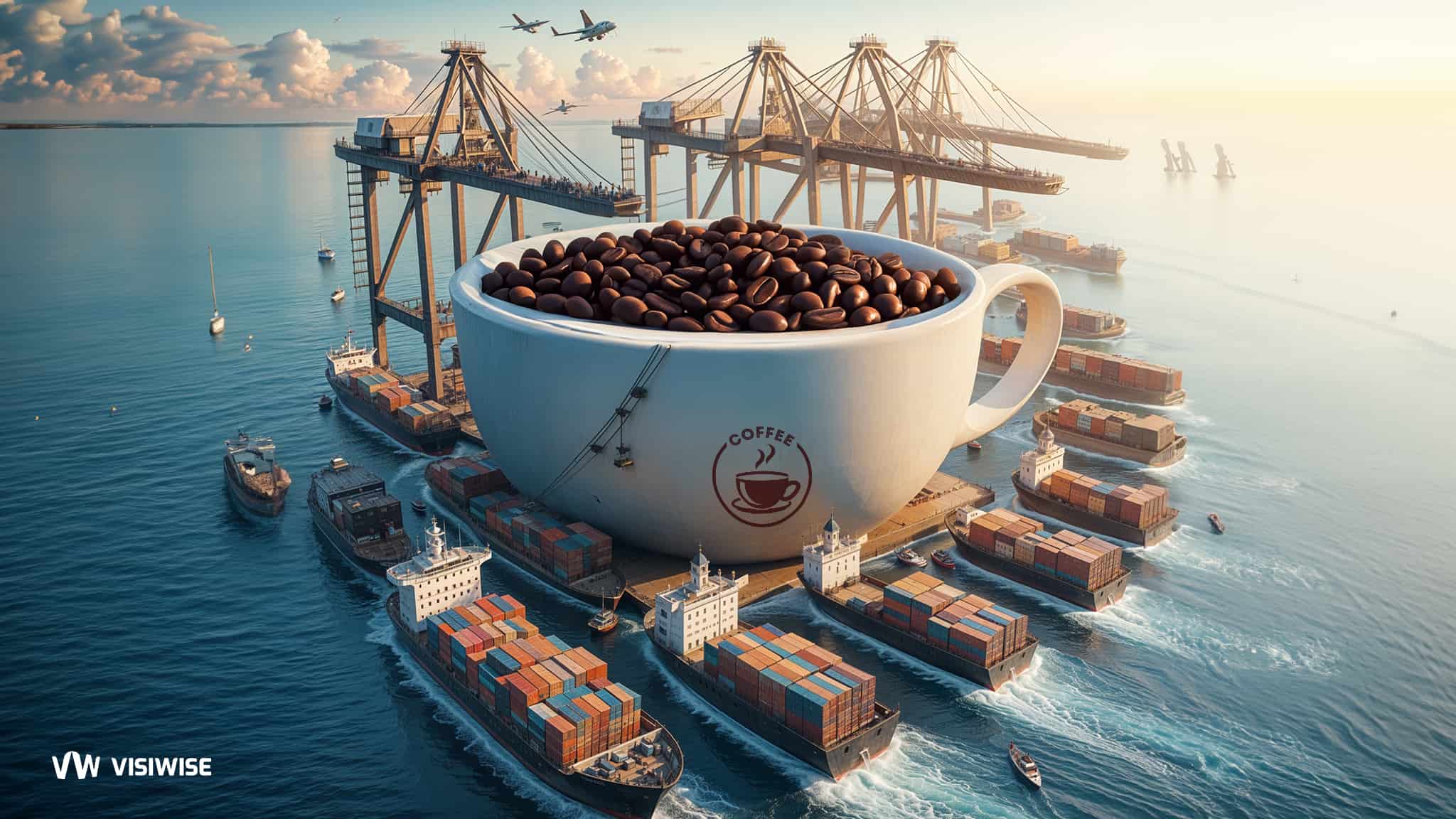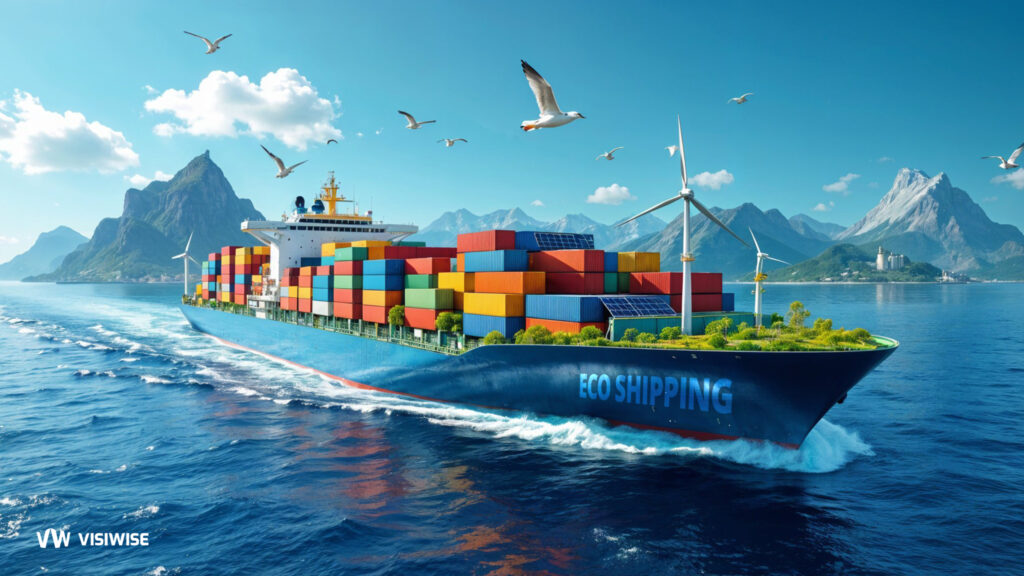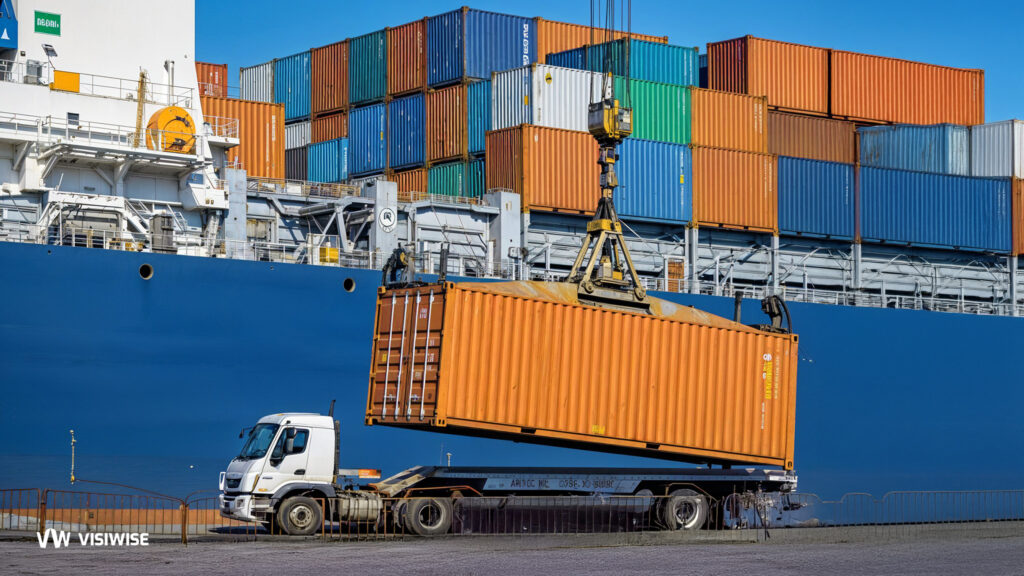Shipping coffee worldwide is a crucial element of the global coffee trade. As coffee consumption rises and demand for specialty and exotic coffees increases, the need for efficient and reliable shipping methods becomes essential. For companies aiming to enter the global coffee market, international coffee shipping presents a significant opportunity for growth and expansion. This process requires meticulous planning, a deep understanding of the coffee supply chain, and knowledge of the complexities involved in international logistics
Understanding the Coffee Supply Chain
The coffee industry is a complex and intricate network of processes that spans multiple regions and involves numerous stakeholders. To appreciate the journey of a cup of coffee from farm to consumer, it is essential to understand the coffee supply chain, encompassing the various stages involved in bringing coffee beans from farmers to the shelves of coffee shops and homes worldwide.
Coffee Cultivation
The coffee supply chain begins with cultivation, predominantly in regions known as coffee belts, such as Central and South America, Africa, and Asia. Smallholder farmers, often working in cooperatives, grow coffee plants and carefully nurture them to produce high-quality cherries. Once the coffee cherries have ripened, they are harvested and undergo processing.
Processing and Grading
After processing, the coffee beans need to be sorted, graded, and prepared for export. This involves removing any defects or impurities, categorizing the beans based on size and quality, and packaging them appropriately. Coffee grading systems, such as the Specialty Coffee Association’s (SCA) protocol, help determine the quality and value of the beans.
International Trade
Once the coffee is ready for export, it enters the international trade market. Exporters and importers play a vital role in facilitating the movement of coffee between producing and consuming countries. They handle logistics, negotiate contracts, arrange shipping, and navigate customs procedures to ensure the smooth flow of coffee across borders.
Arrival and Final Processing
Upon arrival in the destination country, coffee undergoes further processing, including roasting, grinding, and packaging, before it reaches consumers through various channels like coffee shops, supermarkets, or online retailers. This final stage of the supply chain involves the efforts of roasters, distributors, wholesalers, and retailers to bring the coffee to market.
Importance of Understanding the Supply Chain
Understanding the coffee supply chain is crucial for all stakeholders involved, as it allows for better decision-making, quality control, and sustainability practices. By appreciating the complexities and challenges at each stage, coffee businesses can forge stronger partnerships, ensure transparency, and ultimately deliver an exceptional coffee experience to consumers worldwide.
International Shipping Methods for Coffee
When shipping coffee worldwide, selecting the right shipping method is crucial to ensure the timely and safe delivery of coffee beans. Various international shipping methods are available, each with its own advantages and considerations. Here are some common methods used for shipping coffee globally:
Ocean Freight
Ocean freight is a popular choice for shipping large quantities of coffee over long distances. This method is cost-effective and well-suited for bulk shipments. Coffee beans are typically packed in containers, either Full Container Load (FCL) or Less than Container Load (LCL), and transported by cargo ships. However, ocean freight can have longer transit times compared to other methods.
Air Freight
Air freight is a faster shipping option, ideal for smaller quantities of coffee or when time is of the essence. It allows for quicker delivery, reducing the risk of quality degradation. Air freight is generally more expensive than ocean freight due to higher transportation costs, but it offers the advantage of shorter transit times.
Express Courier
Express courier services provide fast and reliable shipping for smaller coffee shipments. This method is suitable for time-sensitive deliveries or smaller orders. Express courier services usually offer door-to-door delivery with tracking capabilities, ensuring greater visibility and security for the shipment. However, it may be costlier compared to other methods, especially for larger volumes.
Intermodal Shipping
Intermodal shipping combines different modes of transportation, such as utilizing both ocean and rail or trucking services. This method can offer a balance between cost-effectiveness and quicker transit times, depending on the specific routes and distances involved. Intermodal shipping provides flexibility and can be tailored to meet the unique needs of coffee shipments.
Choosing the Right Method
When selecting an international shipping method for coffee, consider factors such as budget, volume, destination, and delivery requirements. It is also crucial to work with experienced freight forwarders or shipping agents who specialize in coffee logistics. These professionals can provide guidance on the most suitable shipping method, handle documentation, navigate customs procedures, and ensure compliance with international regulations.
By carefully evaluating the available shipping options and partnering with the right logistics experts, coffee businesses can effectively transport their products worldwide, maintaining the quality, freshness, and integrity of the beans throughout the shipping process.
Exporting and Importing Coffee
Exporting and importing coffee is a crucial part of the global coffee supply chain, connecting coffee-producing regions with coffee-consuming markets worldwide. The process involves various steps, documentation, and considerations to ensure the smooth and efficient movement of coffee across borders. Here is an overview of the processes involved:
Exporting Coffee
Quality Control:
Coffee exporters work closely with farmers and cooperatives to ensure the coffee meets required quality standards. This involves quality assessment, grading, and adherence to specific certifications such as Fair Trade or Organic.
Processing and Packaging:
Exporters oversee the processing and packaging of coffee beans, ensuring they are properly sorted, cleaned, and packaged for export. This includes selecting appropriate packaging materials and labeling the coffee bags with necessary information.
Export Documentation:
Exporters handle the necessary documentation for customs clearance and international trade compliance. This includes commercial invoices, packing lists, certificates of origin, phytosanitary certificates, and any required export permits.
Logistics and Shipping:
Exporters collaborate with freight forwarders and shipping companies to arrange transportation from the origin country to the destination. They manage logistics, negotiate contracts, and ensure proper packaging and handling to protect the coffee’s quality during transit.
Importing Coffee
Sourcing and Procurement:
Coffee importers search for suitable suppliers and establish relationships with producers or exporters in coffee-producing regions. They evaluate the quality, flavor profiles, and sustainability practices of different coffees to meet their market’s demands.
Import Documentation:
Importers handle the necessary import documentation, including customs declarations, import licenses, and compliance with the destination country’s regulatory requirements. They ensure these documents are accurate and complete for smooth customs clearance.
Customs Clearance:
Importers work with customs brokers or agents to facilitate the smooth clearance of coffee through customs. They provide the required documentation, pay any applicable duties or taxes, and ensure compliance with import regulations.
Distribution and Sales:
Importers distribute the imported coffee through various channels, such as wholesalers, retailers, or direct to consumers. They may also provide marketing and promotional support to build awareness and demand for the coffee in their target market.
Dos and Don’ts in Shipping Coffee
The carriage of coffee beans, in both bulk and in bags, presents challenges. The beans are hygroscopic and will contain a significant amount of moisture. This makes them vulnerable to condensation which can lead to wet damage and fungal growth.
The chances of condensation taking place are increased by the transport of the coffee beans from the warm moist growing regions to cooler climates.
The relatively high value of coffee cargoes is another factor to be considered. The value is dependent on the shrub variety, the grade and the market forces. In December 2018, the prices ranged from around 1.80 USD per kg (Robusta) to 3 USD per kg (Arabica). This can result in the total value of cargo within a container approaching 100,000 USD.
This briefing provides loss prevention advice to aid carriers in fulfilling their obligations when carrying bagged coffee cargoes in containers, particularly if considering offering a cargo consolidation service for shippers (i.e. LCL/FCL terms).
Carriage Methods
Coffee beans can be carried in containers either in bulk or bagged.
The former involves the lining of the container with a large oblong polypropylene or polyethylene envelope into which coffee is ‘blown’ and then sealed. Generally, there is less risk of wetting damage by condensation involved with this method.
The main risk when carrying in bagged form is the formation of condensation within the container which then wets the bags. It is generally accepted that it is very difficult to completely eradicate the formation of condensation when carrying in standard dry containers due to the inherent nature of the cargo and the common South-to-North trading routes.
Industry guidelines state that the chance of fungal growth becomes unacceptably high for transportation when the moisture content exceeds 12.5%. Coffee cargoes with moisture content in excess of this should not be shipped.
Bag Material
Although out of the carrier’s control, the bag material may be an influence. Natural fiber bags are preferred by the industry and are favoured above woven polypropylene bags. This is thought to be because the latter does not allow the same level of circulation of air through the weave, even if they are generally considered to be more resilient.
However, some experts are not convinced the air circulation rate through the weave has any relevance to the condensation risk and that the bagging material may be more relevant to what happens after wetting.
Natural fiber bags absorb moisture whereas polypropylene weave bags shed much of the moisture which can then run off and affect more bags below.
Stowage in Containers
Transporting bagged coffee cargo in standard dry containers is generally the cheapest option and therefore the most commonly used method. Such containers are often referred to as being unventilated and although they are fitted with vent holes in each corner, these holes do not provide for effective air exchange and are only for air pressure equalization.
The air inside an unventilated container is in equilibrium with the moisture held in the cargo, and its dew point is determined by the moisture content and the temperature of the coffee beans. Condensation will form whenever the internal surfaces of the container are cooler than the dew point of the air inside the container.
Bagged coffee cargoes carried in unventilated containers will inevitably be susceptible to condensation when subject to changes in temperature. If the container remains exposed to ambient temperatures below the dew point of the air within the container then the generation of condensation will be a continuous process.
- The generation of condensation can be influenced by the following factors:
- Moisture content of the coffee
- Temperature of the bagged cargo at loading
- Expected changes in outside temperature between origin and destination and during transit
- The container (and its contents) being exposed to direct sunlight in hot climates
- Length of time the container will remain in cold conditions where the outside temperature is significantly lower that the dew point of the air inside the container.
Use of Lining
When shipping in unventilated containers, it has been the custom of the trade to apply lining in order to prevent any condensation coming into direct contact with the bagged cargo.
Present industry guidelines recommend the use of corrugated cardboard as a lining material. The corrugations should face the steel of the container sidewalls. But it has also been customary to use two sheets of Kraft paper as an alternative.
When condensation is formed, there is significant reliance on the absorption characteristics of the lining material.
Although industry guidance is well established, it makes no direct reference to the specification of the cardboard and Kraft paper or the quantity that should be applied. This absence
of detail is particularly pertinent as it might be considered that there is a direct correlation between the lining’s weight or thickness and its capacity to absorb free moisture.
Some experts are of the opinion that the thickness of Kraft paper, or indeed the number of layers, has little effect on the degree of protection it offers – water dripping onto Kraft paper results in the paper becoming wet to the touch on both sides.
Corrugated cardboard is different. Initial dripping will only result in the top surface becoming wet, with the corrugations providing some protection to the surface facing the coffee bags. Cardboard with two smooth surfaces on either side of the corrugations is therefore preferable to cardboard with open corrugations.
But as the generation of condensation within an unventilated container is both an inevitable and a potentially continual process, any absorption capabilities of the lining material may be exceeded and wetting damage may be unavoidable.
Ambient Conditions
Ideally, the moisture content of the cargo and its surrounding air should remain balanced and even.
To achieve this, the temperature within the container must remain constant. But in practice this is impossible when using unventilated containers to ship cargoes from warmer to cooler climates.
The effect is further pronounced during the Northern Hemisphere winter when the container will be exposed to much colder weather at discharge. Shippers and carriers should be aware of this increased risk.
Alternative Measures
The main alternatives to using standard dry containers are
the ventilated container and the refrigerated (reefer) container. Additionally, desiccants can be considered.
Ventilated Containers: These have ventilation openings over the entire length of the top and bottom side rails. However, the use of this type of container is generally more expensive and there is limited availability.
Ventilated containers rely on air flow. When on board the carrying vessel, ventilated containers should be carried under-deck as the ventilation is at its most effective when subject to the forced air flow in the ship’s holds. If stowed on deck, ventilated containers need to be protected from the elements that would normally be experienced at sea.
Reefer Containers: Coffee can also be carried in reefer containers. This allows the temperature – and in some cases the humidity – to be controlled. The reefer should be fitted with drain holes to remove the collected condensation and the carrier must ensure they have received clear written carriage instructions from the shipper with regard to temperature set points, ventilation and humidity settings.
As with ventilated containers, the costs of using reefer containers are greater than those associated with standard dry containers.
Desiccants: Desiccants, such as ‘dry-bags’, are sometimes used inside the container. But be aware that the effectiveness of desiccants for hygroscopic commodities such as coffee is limited as their absorption potential is very small compared to amount of moisture held inside the beans.
It is understood that many receivers do not permit the use of desiccants so prior express agreement is essential.
Carrier’s Liabilities
Stuffing is generally undertaken by the shipper or their appointed agents. If the shipper packs the bagged coffee cargo and applies the lining then they are responsible for the correct stowage as well as the quality and appropriateness of the lining.
Carriers looking to offer the service of stuffing these cargoes in unventilated containers and carrying on a LCL/FCL basis should be fully aware of the risks.
A “Sound System” and the Burden of Proof
Volcafe v CSAV* concerned such a case when several dry standard containers of bagged coffee cargo were shipped on LCL/FCL terms, where the carrier assumed responsibility for the stuffing of the container and applying protective lining.
In this case, stuffing was carried out by the carrier’s agents in South America and the containers were shipped to Northern Europe during the Northern Hemisphere winter. At out-turn, bags at the top and periphery of the stow were reportedly wet and mouldy through the generation of condensation within the container
At first instance, the judge found that the carrier had failed to establish that it had adopted a “sound system” to prevent condensation damage despite following the custom of the industry.
The first instance decision raised two concerns: it found that a “sound system” was not necessarily one that was in accordance with standard industry practice and it placed the burden of proving absence of negligence on the carrier.
The Court of Appeal overruled both of these points. This re-established the position that a “sound system” is one which is in accordance with the standard industry practice as well as shifting the burden of proof back on the cargo interests rather than the carrier.
The Court of Appeal also confirmed that when cargoes are carried on LCL/FCL terms, the stuffing of a container is part of the “loading” operation. If the carrier has assumed responsibility for the stuffing of the container, then their obligations under The Hague (or Hague-Visby) Rules Article III (2) are extended to cover this operation.
The case went to the UK Supreme Court in 2018. The judgment did not change the Court of Appeal’s determination of what amounts to a “sound system”. However, it concluded that, in circumstances where the goods were shipped in apparent good order but discharged damaged, the carrier bears the burden of proving absence of negligence or prove that it was caused by an excepted peril.
However, cargo interests remain under an evidential burden to show that (a) cargo was loaded in apparent good order and condition and (b) that it was discharged damaged.
*Volcafe v CSAV is a landmark case decided by the UK Supreme Court in 2018, which significantly impacts the handling of cargo claims under English law. The case centers on the burden of proof in claims for loss or damage to cargo and has important implications for carriers, shipowners, and their claim handlers.
Loss Prevention
- A key point to remember is that the generation of condensation is inevitable when carrying bagged coffee cargoes from warm to cool climates in standard dry unventilated containers.
- The protection afforded to the cargo by the application of lining, using either corrugated cardboard or Kraft paper has limitations. Even if lining is applied in accordance with present industry practice there is no guarantee that the cargo will remain protected from condensation.
- Carriers who have assumed responsibility for stuffing should be able to prove a sound system is in place. One indication of a sound system is that it is in accordance with industry standards. The carrier must also show it applied that system carefully.
- Maintaining photographic and documentary evidence that details the stuffing operation may assist a carrier in defending a future damage claim. A record of the specification that includes thickness of any Kraft paper used should also be retained.
- To reduce the rate of condensation generation within an unventilated container, give consideration to any reasonably practicable methods of preventing prolonged exposure to temperature extremes.
- The period of time from stuffing the container to loading on board the carrying vessel should be as short as possible. This also applies to stays at intermediate or transfer ports. ISO 8455:2011 Green Coffee – Guidelines for Storage and Transport recommends that the transferring time in ports be no longer than 72h.
- The period of time from vessel discharge to delivery to the consignee should be as short as reasonably practicable. The receiver should de-van the container without delay.
- The container should be protected, as far as reasonably practicable, from heat sources and sources of taint at all stages of the shipment.
- When carrying on LCL/FCL terms, the stuffing of a container is part of the “loading” operation under The Hague or Hague- Visby Rules. If the carrier has assumed responsibility for stuffing, then their obligations are extended to this operation.
- Carriers should remember that following the Volcafe v CSAV Supreme Court decision of 2018, they bear the burden of proving absence of negligence or prove that it was caused by an excepted peril in the event of cargo damage when loaded in apparent good order. Collecting and maintaining evidence to support the carrier’s position now has increased importance.



